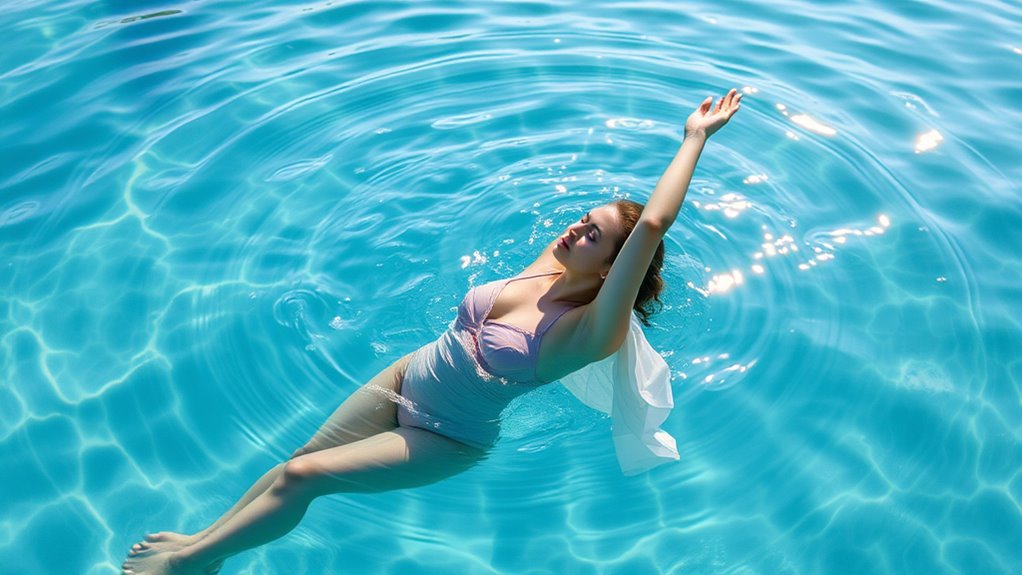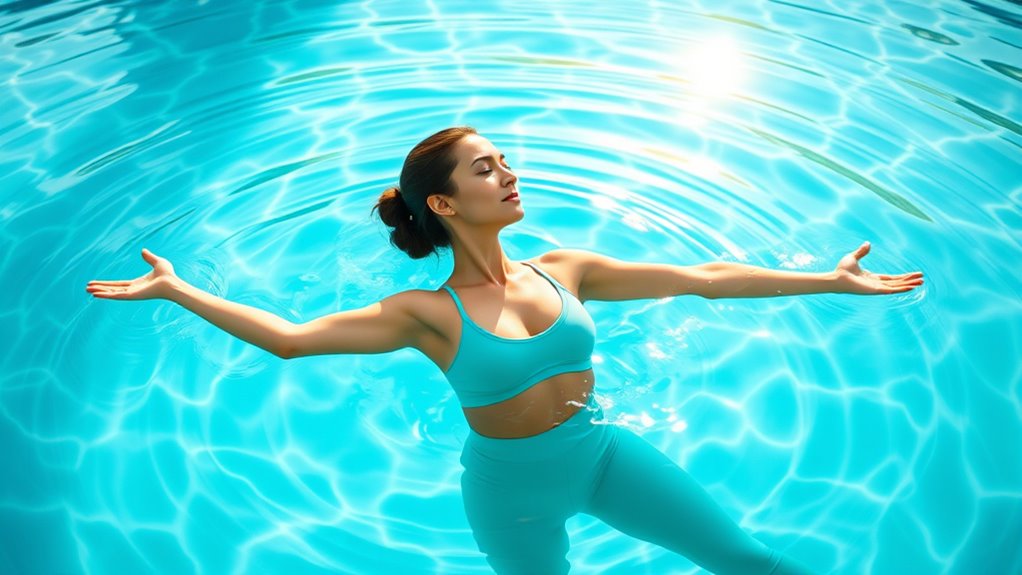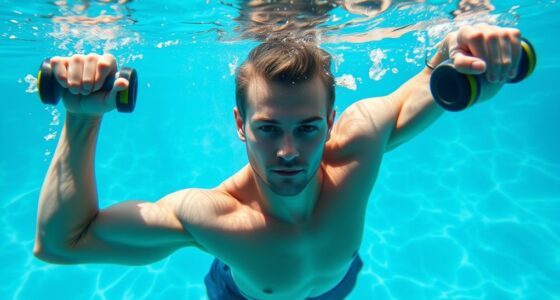Aqua yoga provides a gentle, supportive way to stretch, strengthen, and relax in the water. The water’s buoyancy reduces impact on your joints, making movements easier and safer, especially if you’re recovering from injury or dealing with arthritis. It also enhances your body awareness and focus on your breath, helping you relax more deeply. As you explore this calming practice, you’ll discover how water properties amplify your flexibility and overall well-being. Keep exploring to learn more about how aqua yoga transforms your routine.
Key Takeaways
- Aqua yoga uses water resistance to enhance gentle stretching and improve muscle strength without strain.
- Buoyancy supports joints and spine, enabling safe, deeper stretches and easing movement.
- The water environment promotes relaxation, reduces stress, and enhances focus on breath and alignment.
- Aqua yoga is ideal for injury recovery, arthritis, or low-impact workouts, offering safe, accessible exercise options.
- Combining water properties with slow movements deepens flexibility, boosts circulation, and encourages mindful body awareness.

Have you ever wondered how practicing yoga in water can enhance your workout? When you step into the pool, you immediately feel the unique environment that water provides. Water resistance plays a vital role here, offering gentle but firm opposition to your movements. Unlike traditional yoga on land, the resistance from the water slows down your motions, allowing you to focus more on proper alignment and deep breathing. This resistance isn’t just a challenge; it’s a benefit. It helps strengthen your muscles without the need for heavy weights, making each stretch and pose more effective. As you move through your practice, you’ll notice how water resistance encourages controlled, deliberate movements, which can improve your balance and stability over time.
Water resistance enhances yoga by slowing movements, improving alignment, and strengthening muscles without heavy weights.
The buoyancy effects of water are equally impactful. Buoyancy reduces the impact on your joints and spine, making yoga accessible even if you’re dealing with injury or arthritis. When you float in the water, your body is partially supported, which alleviates pressure on sore or stiff areas. This support enables you to stretch deeper and hold poses longer without strain or discomfort. You might find yourself effortlessly shifting between poses, feeling a sense of weightlessness that’s impossible on land. This sensation encourages relaxation and helps you sink into each stretch more fully. Because of buoyancy, you can explore movements that might be difficult or painful on dry ground, pushing your flexibility and range of motion gently and safely.
Practicing yoga in water also enhances your mind-body connection. The sensory experience of water — its temperature, pressure, and resistance — heightens your awareness of your body’s positioning and movements. You become more conscious of your breath and alignment, which is essential for effective yoga practice. The calming nature of water combined with slow, mindful movements can lower stress levels and promote a sense of peace. Plus, the cool or warm water temperature can boost circulation and help relax tense muscles, further easing your body into each pose. Additionally, the integration of technology such as Intelligent Tutoring Systems could support personalized guidance for beginners or those seeking to improve technique in aqua yoga sessions.
In essence, water resistance and buoyancy effects transform traditional yoga into a gentle, supportive, and effective workout. They allow you to deepen your stretches, strengthen muscles, and enjoy a calming, low-impact experience. Whether you’re recovering from an injury, looking for a relaxing way to stay active, or simply want to add variety to your routine, aqua yoga offers a unique blend of physical challenge and relaxation. It’s a practice that makes the most of water’s natural properties, helping you feel more flexible, stronger, and more at peace with each session.
Frequently Asked Questions
Can Aqua Yoga Help Improve Arthritis Symptoms?
You’re wondering if aqua yoga can help with arthritis symptoms, right? Water therapy, including aqua yoga, can reduce arthritis pain by easing joint pressure and promoting gentle movement. The buoyancy of water supports your body, making stretching easier and less painful. Regular practice can improve flexibility, decrease stiffness, and enhance overall comfort. So, if you’re seeking a low-impact way to manage arthritis, aqua yoga might be a great option to contemplate.
What Equipment Is Needed for Aqua Yoga Sessions?
For aqua yoga sessions, you mainly need water-resistant mats to provide stability and floating props to assist with balance and support. These tools make your practice more comfortable and accessible, especially in a pool setting. You won’t need traditional yoga equipment like blocks or straps, as the water itself offers natural resistance. Bring these items, and you’re ready to enjoy gentle stretching and relaxation in the water.
Is Aqua Yoga Suitable for Pregnant Women?
Did you know over 70% of pregnant women find water activities helpful? Aqua yoga offers prenatal benefits like reduced joint pain and improved circulation. You should always prioritize water safety and consult your healthcare provider before starting. If cleared, aqua yoga can be a gentle, supportive way to stay active, relax, and prepare for childbirth, making it a safe and effective option during pregnancy.
How Often Should Beginners Practice Aqua Yoga?
You should practice aqua yoga 2 to 3 times a week as a beginner. This practice frequency helps you build strength, improve flexibility, and stay relaxed without overexerting yourself. Remember to listen to your body, take breaks when needed, and focus on proper breathing. Beginner tips include starting with gentle routines, staying hydrated, and gradually increasing your session duration to avoid fatigue. Consistency is key to seeing progress.
Are There Any Age Restrictions for Aqua Yoga Participants?
Did you know that aqua yoga is suitable for all ages? There aren’t strict age restrictions, but water temperature and your mobility matter most. If you’re over 60 or have limited mobility, you can still enjoy it safely, as the water supports your movements. Always make certain the water’s warm enough—around 92°F—to keep muscles relaxed. So, whether you’re young or old, aqua yoga can be a beneficial activity for everyone!
Conclusion
So, next time you’re feeling overwhelmed, maybe skip the stress ball and immerse yourself in aqua yoga instead. Who knew that floating around and stretching gently could be the ultimate stress reliever? It’s almost funny—you’re relaxing in water while everyone else is stuck in traffic or at their desks. Turns out, the best way to stay grounded is to simply float away. So, go ahead, make a splash and relax—you’ve earned it!









